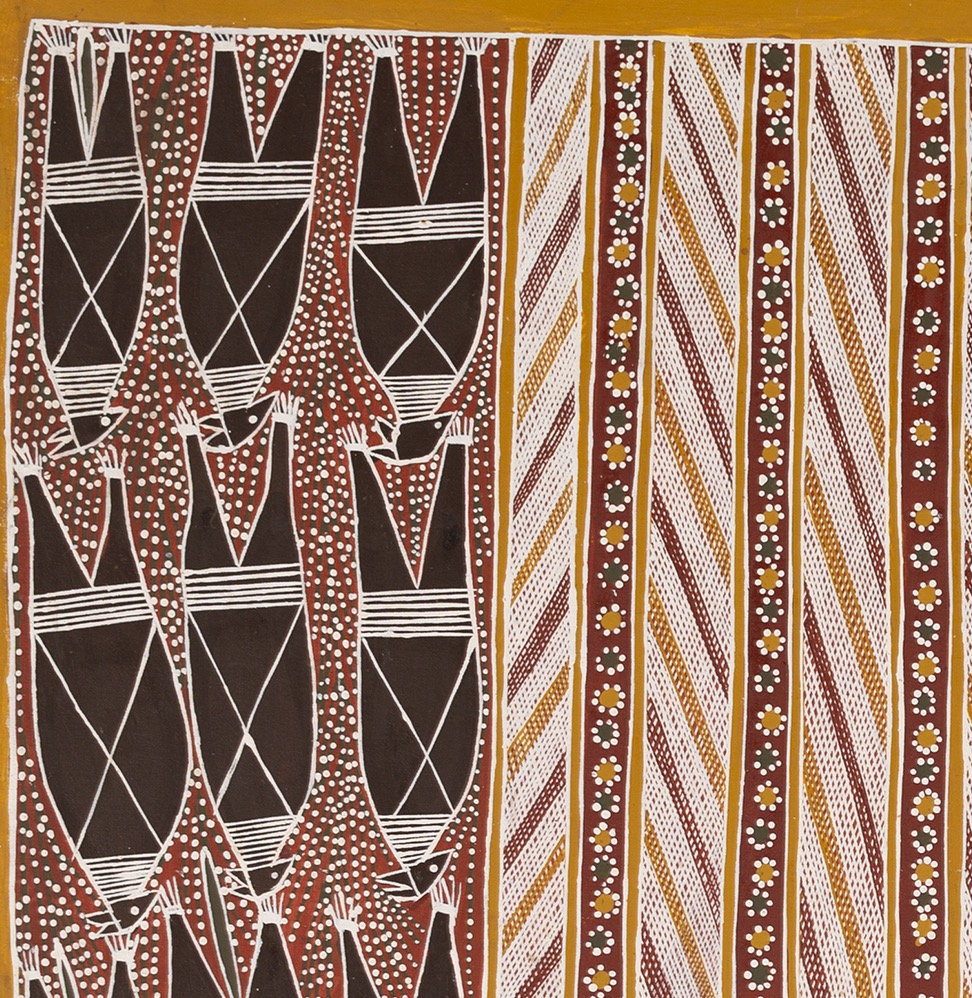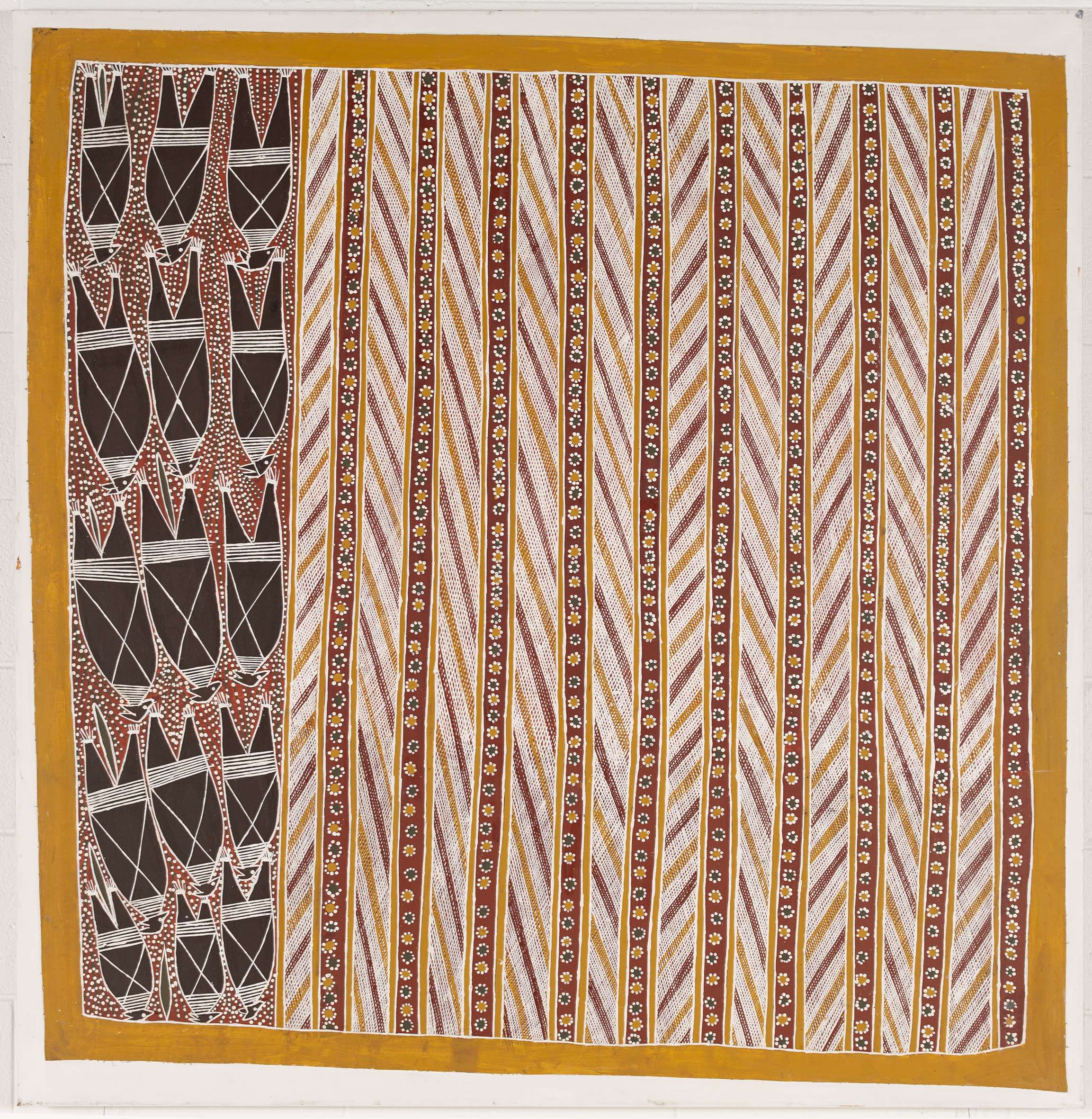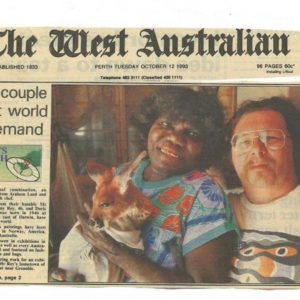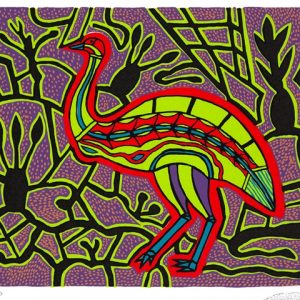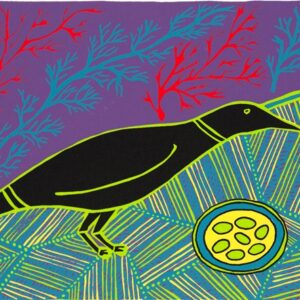Description
- Medium: Acrylic on cotton canvas, stretched
- Size: 130 x 130 cm
- Artist skin name: Bulanydjan
- Lived: C1942 – 2019
- Language group: Ganalbingu
- Clan: Gurrumba Gurrumba
- Community: Ramingining, NT
Stone spearheads
Dorothy began to paint the spearheads after working on paintings with her husband Djardie Ashley (see below). The totemic Ngambi stone spearheads were made at a site called Ngilipitgi southeast of Ramingining. These spearheads are associated with the Wagilag Sisters’ story, an important Aboriginal creation myth.
He said: “My brother Ray showed me these pictures. This painting I do comes from the Dreamtime. We remember what our father and grandfather taught us so we can hold onto our culture and show our children. This Ngambi is very important, our luku (footprints) for us. It’s body painting for us”.
Dorothy Djukulul
Dorothy Djukulul was born on 10 June 1942 at Murrwangi, near the Arafura Swamp in Arnhem Land. During her childhood, Djukulul and her family lived on Milingimbi Island, where she attended a Methodist school. Early in her career, Djukulul worked in a bakery in the newly established trading post in Maningrida, an Aboriginal community. After finishing school Djukulul and her family moved back to Ramingining on the mainland. After marrying her first husband, she moved to Maningrida, a community to the west of Ramingining, but after his death she moved back Djukulul married her second husband, Djardie Ashley, in 1978.
Djukulul and her brother George Milpurrurru learned to paint from their father, Ngulmarmar. Ngulmarmar was a distinguished bark painter whose works have hung in numerous major art galleries and have been featured in books of art. Djukulul was one of the first women painters in central Arnhem Land and was also permitted to paint images normally restricted to male artists. This is because Ngulmarmar was afraid that some of the art and sacred stories would die out if his son were unable to pass them on. He asked the tribal elders to allow Djukulul to paint these designs, thus preserving the sacred art of the Ganalbingu tribe.
Djukulul practiced her art in Ramingining in Central Arnhem Land, Northern Territory. She made several pieces with her husband Djardie Ashley (born 1950), including at the Aboriginal Artist Gallery in Melbourne in 1984 and 1986.
Djukulul was one of several artists who created The Aboriginal Memorial, an installation of 200 carved and painted log coffins intended to commemorate the deaths of Aboriginal people from European settlement. The installation, built in the late 1980s, was first put on display in Sydney in 1988, and now permanently on display at the National Gallery of Australia in Camberra.
Djukulul and Djardie Ashley, exhibited their work together, including two shows at the Aboriginal Artist Gallery in Melbourne (1984 & 1986). Ten of their paintings in the Artist Gallery in Melbourne were acquired for the Robert Holmes a Court Collection. Djukulul has also participated in many group exhibitions.
In 1991, Djukulul was the recipient of a commission for John Kluge title “Painting the Land Collection” in Virginia, USA.
Djukulul was included in the project called Twelve Canoes which was based on the film Ten Canoes (2013). This project strived to highlight key aspects of Yolngu culture in Ramingining. Several works by Djukulul were included in this project.
Bula’Bula Arts – Ramingining
Bula’bula Arts is a remote community art centre based in Ramingining, Central Arnhem Land. It promotes and markets the work of local artists. Bula’bula Arts is renowned for paintings on bark and canvas, hollow logs and fibre art such as baskets, mats and dilly-bags, as well as limited edition prints on paper. Bula’bula Arts is an Aboriginal Corporation owned by the artists of Ramingining and surrounding outstations.
Provenance: this artwork is from Bula’bula Arts and in the collection of Anne Phelan and John Clark of Framed Gallery in Darwin 1983-2017. Framed Gallery held exhibitions of artworks by Djambu and his wife Amy.

